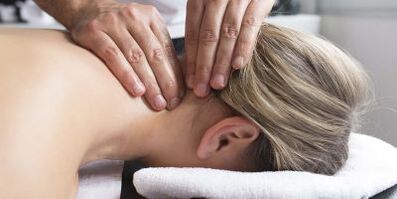
Now, there is virtually no person over the age of 25 who does not experience problems with the spine. One of the most common pathologies is damage to the cervical vertebrae, which inevitably progresses untreated and causes more and more discomfort to the patient.
What is osteochondrosis
There are degenerative-dystrophic changes in cervical spine osteochondrosis in the joints and intervertebral discs.
With the progression of cervical osteochondrosis, the following symptoms begin to appear:
decreased visual acuity and hearing;
numbness of the tongue;
darkens in the eyes with a sharp neck turn, dizzy;
there is a throbbing pain in the back of the head that can radiate to the temple and crown;
pain in the cervical spine and shoulders, even during sleep, disturbs the patient and is aggravated by movement or effort;
the neck is stiff, especially in the morning;
pressure in the sternum;
shortness of breath, feeling of shortness of breath.
Due to the fact that the spinal cord does not receive enough nutrients, the range of motion and the sensitivity of the upper and lower limbs are significantly reduced.
Causes of cervical osteochondrosis
Predisposition to cervical osteochondrosis is inherited. In addition, common causes of pathology include:
unbalanced diet;
scoliosis;
goosefoot;
VSD;
tension;
spinal injuries and bruises;
excessive physical activity;
rheumatism;
sedentary lifestyle;
overweight.
Reference! The main cause of osteochondrosis is a violation of mineral metabolism, which can be accompanied by calcium deficiency or hormonal disorders. Women often face this pathology during pregnancy and menopause.
Diagnostics
The following diagnostic methods are used to determine the extent of degenerative changes in the spine:
Doppler ultrasound of the carotid and vertebral arteries. It allows the detection of spasmodic blood vessels and violations of the blood supply to the brain and spinal cord.
Audiography for testing auditory function.
Ultrasound.
CT and MRI of the head and cervical spine. The purpose is to assess the area of the lesion, check the position of the intervertebral discs, and detect spinal cord and vascular compression.
Blood test.
X-ray in the early stages of pathology.
Electroneuromyography showing the presence of inflammation, stinging, and nerve damage.
Duplex scanning of head vessels.
Reference! All of these procedures are most conveniently performed in one location, such as a treatment and rehabilitation center, where diagnostics are performed with modern equipment.
Which doctor treats you
If you develop symptoms of cervical osteochondrosis, you should not start treatment immediately. First, ask for an appointment with a neurologist. The specialist performs the examination and then directs the patient to the necessary examinations.
Important! Performing manual therapy and other treatments without prior diagnosis threatens injuries and exacerbates existing problems.
Treatment methods
Once the diagnosis is made, the patient can continue treatment. Senior professionals work in treatment and rehabilitation centers, so the likelihood of complications is minimal.
The main method of treating cervical osteochondrosis is manual therapy. The specialist performs a massage that relaxes the neck and shoulders, restores the vertebrae and joints to their natural position, and seeks to normalize lymphatic flow and blood circulation.
Hand therapy is often combined with therapeutic exercises to tune the neck muscles. In addition, medication and physiotherapy are used to get rid of the pathology.
results
As a result of the therapy, the nerve endings get rid of the sting, the spine stabilizes, and the pain disappears or decreases. The chiropractor is able to straighten the vertebrae and increase the distance between the damaged plates, thus eliminating friction.
Important! Grade 2 and 3 osteochondrosis cannot be completely cured. But therapy and rehabilitation allow the patient to restore impaired spinal functions as much as possible.
Rehabilitation and lifestyle recovery
Treatment and rehabilitation centers provide not only the diagnosis and treatment of cervical osteochondrosis, but also rehabilitation measures. The patient leaves the center healthy and is ready to return to his or her normal lifestyle as soon as possible.
The goal of rehabilitation is not only to restore spinal function, but also to prevent damage to healthy tissues. The program is designed taking into account the severity of the pathology and the presence of complications. Physiotherapy procedures, massage, training therapy, mud applications have proved their worth. If the patient still has pathological symptoms, medication blockade is prescribed.
Lifestyle in cervical osteochondrosis
To avoid recurrence of the disease, follow these recommendations:
change body position at least every half hour;
do not lift loads weighing more than 5 kg;
walk more, do physiotherapy, swim, Pilates;
it is preferable to use a backpack instead of a bag;
take ten-minute breaks per hour in a sitting position.
Important! The position of the human body during sleep is very important. You should sleep on your back on a medium strength orthopedic mattress and orthopedic pillow. In this case, the head and neck should lie on the pillow and the shoulders on the mattress.
Treatment of cervical osteochondrosis is most effective in the early stages, so a visit to a neurologist should not be postponed. But it is possible to stop the progression of the disease and improve the quality of life, regardless of the degree of damage to the joints and intervertebral discs. To do this, it is important that you do not waste time and follow the recommendations of a specialist.

















































